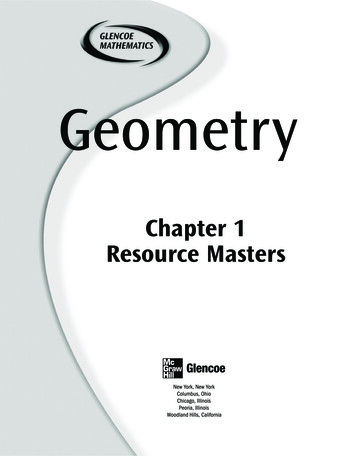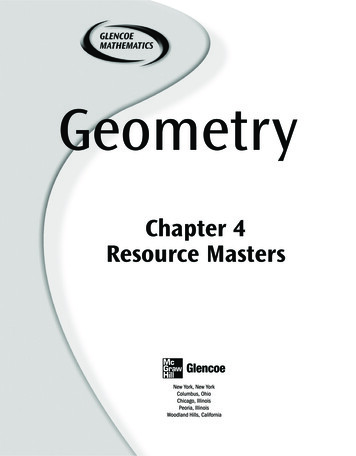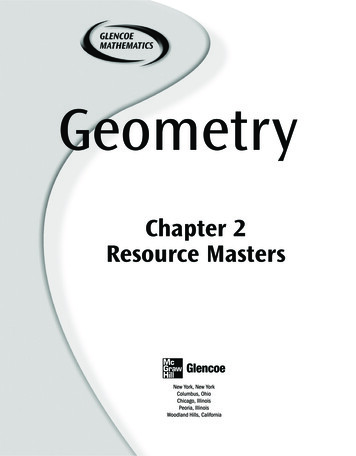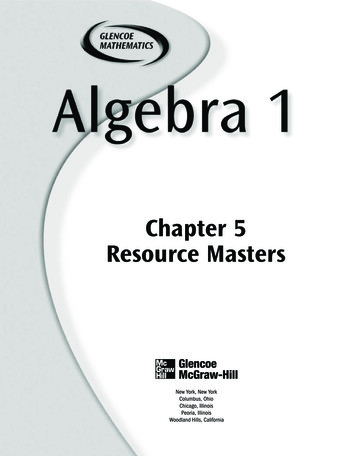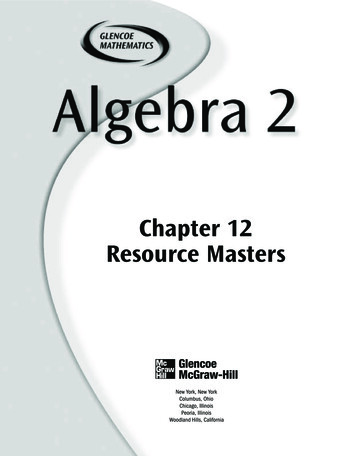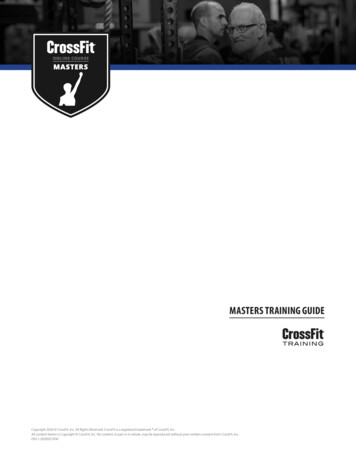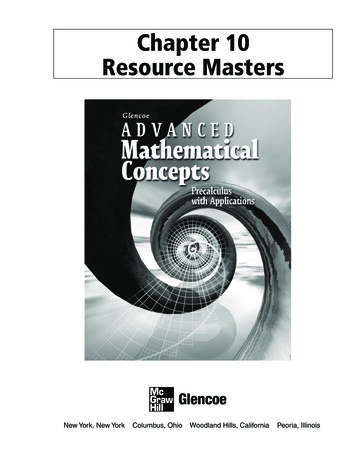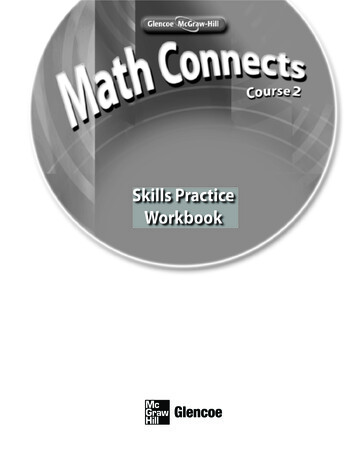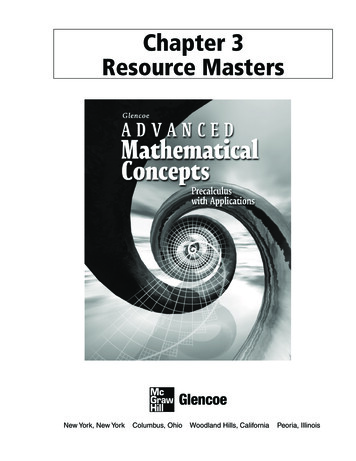
Transcription
Chapter 3Resource MastersNew York, New YorkColumbus, OhioWoodland Hills, CaliforniaPeoria, Illinois
StudentWorksTM This CD-ROM includes the entire Student Edition along with theStudy Guide, Practice, and Enrichment masters.TeacherWorksTM All of the materials found in this booklet are included for viewingand printing in the Advanced Mathematical Concepts TeacherWorksCD-ROM.Copyright The McGraw-Hill Companies, Inc. All rights reserved.Printed in the United States of America. Permission is granted to reproducethe material contained herein on the condition that such material be reproduced onlyfor classroom use; be provided to students, teachers, and families without charge;and be used solely in conjunction with Glencoe Advanced Mathematical Concepts.Any other reproduction, for use or sale, is prohibited without prior writtenpermission of the publisher.Send all inquiries to:Glencoe/McGraw-Hill8787 Orion PlaceColumbus, OH 43240-4027ISBN: 0-07-869130-31 2 3 4 5 6 7 8 9 10Advanced Mathematical ConceptsChapter 3 Resource MastersXXX11 10 09 08 07 06 05 04
ContentsVocabulary Builder . . . . . . . . . . . . . . . . . vii-xLesson 3-7Study Guide . . . . . . . . . . . . . . . . . . . . . . . . . 105Practice . . . . . . . . . . . . . . . . . . . . . . . . . . . . . 106Enrichment . . . . . . . . . . . . . . . . . . . . . . . . . . 107Lesson 3-1Study Guide . . . . . . . . . . . . . . . . . . . . . . . . . . 87Practice . . . . . . . . . . . . . . . . . . . . . . . . . . . . . . 88Enrichment . . . . . . . . . . . . . . . . . . . . . . . . . . . 89Lesson 3-8Study Guide . . . . . . . . . . . . . . . . . . . . . . . . . 108Practice . . . . . . . . . . . . . . . . . . . . . . . . . . . . . 109Enrichment . . . . . . . . . . . . . . . . . . . . . . . . . . 110Lesson 3-2Study Guide . . . . . . . . . . . . . . . . . . . . . . . . . . 90Practice . . . . . . . . . . . . . . . . . . . . . . . . . . . . . . 91Enrichment . . . . . . . . . . . . . . . . . . . . . . . . . . . 92Chapter 3 AssessmentChapter 3 Test, Form 1A . . . . . . . . . . . . 111-112Chapter 3 Test, Form 1B . . . . . . . . . . . . 113-114Chapter 3 Test, Form 1C . . . . . . . . . . . . 115-116Chapter 3 Test, Form 2A . . . . . . . . . . . . 117-118Chapter 3 Test, Form 2B . . . . . . . . . . . . 119-120Chapter 3 Test, Form 2C . . . . . . . . . . . . 121-122Chapter 3 Extended ResponseAssessment . . . . . . . . . . . . . . . . . . . . . . . 123Chapter 3 Mid-Chapter Test . . . . . . . . . . . . . 124Chapter 3 Quizzes A & B . . . . . . . . . . . . . . . 125Chapter 3 Quizzes C & D. . . . . . . . . . . . . . . 126Chapter 3 SAT and ACT Practice . . . . . 127-128Chapter 3 Cumulative Review . . . . . . . . . . . 129Lesson 3-3Study Guide . . . . . . . . . . . . . . . . . . . . . . . . . . 93Practice . . . . . . . . . . . . . . . . . . . . . . . . . . . . . . 94Enrichment . . . . . . . . . . . . . . . . . . . . . . . . . . . 95Lesson 3-4Study Guide . . . . . . . . . . . . . . . . . . . . . . . . . . 96Practice . . . . . . . . . . . . . . . . . . . . . . . . . . . . . . 97Enrichment . . . . . . . . . . . . . . . . . . . . . . . . . . . 98Lesson 3-5Study Guide . . . . . . . . . . . . . . . . . . . . . . . . . . 99Practice . . . . . . . . . . . . . . . . . . . . . . . . . . . . . 100Enrichment . . . . . . . . . . . . . . . . . . . . . . . . . . 101SAT and ACT Practice Answer Sheet,10 Questions . . . . . . . . . . . . . . . . . . . . . . . A1SAT and ACT Practice Answer Sheet,20 Questions . . . . . . . . . . . . . . . . . . . . . . . A2ANSWERS . . . . . . . . . . . . . . . . . . . . . . A3-A17Lesson 3-6Study Guide . . . . . . . . . . . . . . . . . . . . . . . . . 102Practice . . . . . . . . . . . . . . . . . . . . . . . . . . . . . 103Enrichment . . . . . . . . . . . . . . . . . . . . . . . . . . 104 Glencoe/McGraw-HilliiiAdvanced Mathematical Concepts
A Teacher’s Guide to Using theChapter 3 Resource MastersThe Fast File Chapter Resource system allows you to conveniently file theresources you use most often. The Chapter 3 Resource Masters include the corematerials needed for Chapter 3. These materials include worksheets, extensions,and assessment options. The answers for these pages appear at the back of thisbooklet.All of the materials found in this booklet are included for viewing and printing inthe Advanced Mathematical Concepts TeacherWorks CD-ROM.Vocabulary Builder Pages vii-x include aPractice There is one master for each lesson.student study tool that presents the keyvocabulary terms from the chapter. Students areto record definitions and/or examples for eachterm. You may suggest that students highlight orstar the terms with which they are not familiar.These problems more closely follow thestructure of the Practice section of the StudentEdition exercises. These exercises are ofaverage difficulty.When to Use These provide additionalpractice options or may be used as homeworkfor second day teaching of the lesson.When to Use Give these pages to studentsbefore beginning Lesson 3-1. Remind them toadd definitions and examples as they completeeach lesson.Enrichment There is one master for eachlesson. These activities may extend the conceptsin the lesson, offer a historical or multiculturallook at the concepts, or widen students’perspectives on the mathematics they arelearning. These are not written exclusivelyfor honors students, but are accessible for usewith all levels of students.Study Guide There is one Study Guidemaster for each lesson.When to Use Use these masters asreteaching activities for students who needadditional reinforcement. These pages can alsobe used in conjunction with the Student Editionas an instructional tool for those students whohave been absent. Glencoe/McGraw-HillWhen to Use These may be used as extracredit, short-term projects, or as activities fordays when class periods are shortened.ivAdvanced Mathematical Concepts
Assessment OptionsIntermediate AssessmentThe assessment section of the Chapter 3Resources Masters offers a wide range ofassessment tools for intermediate and finalassessment. The following lists describe eachassessment master and its intended use.Chapter Tests Forms 1A, 1B, and 1C Form 1 tests containmultiple-choice questions. Form 1A isintended for use with honors-level students,Form 1B is intended for use with averagelevel students, and Form 1C is intended foruse with basic-level students. These testsare similar in format to offer comparabletesting situations.Forms 2A, 2B, and 2C Form 2 tests arecomposed of free-response questions. Form2A is intended for use with honors-levelstudents, Form 2B is intended for use withaverage-level students, and Form 2C isintended for use with basic-level students.These tests are similar in format to offercomparable testing situations.The Extended Response Assessmentincludes performance assessment tasks thatare suitable for all students. A scoringrubric is included for evaluation guidelines.Sample answers are provided forassessment. Glencoe/McGraw-Hill Four free-response quizzes are included tooffer assessment at appropriate intervals inthe chapter. The SAT and ACT Practice offerscontinuing review of concepts in variousformats, which may appear on standardizedtests that they may encounter. This practiceincludes multiple-choice, quantitativecomparison, and grid-in questions. Bubblein and grid-in answer sections are providedon the master. The Cumulative Review provides studentsan opportunity to reinforce and retain skillsas they proceed through their study ofadvanced mathematics. It can also be usedas a test. The master includes free-responsequestions.AnswersAll of the above tests include a challengingBonus question. A Mid-Chapter Test provides an option toassess the first half of the chapter. It iscomposed of free-response questions.Continuing AssessmentChapter Assessments v Page A1 is an answer sheet for the SAT andACT Practice questions that appear in theStudent Edition on page 203. Page A2 is ananswer sheet for the SAT and ACT Practicemaster. These improve students’ familiaritywith the answer formats they mayencounter in test taking. The answers for the lesson-by-lessonmasters are provided as reduced pages withanswers appearing in red. Full-size answer keys are provided for theassessment options in this booklet.Advanced Mathematical Concepts
Chapter 3 Leveled WorksheetsGlencoe’s leveled worksheets are helpful for meeting the needs of everystudent in a variety of ways. These worksheets, many of which are foundin the FAST FILE Chapter Resource Masters, are shown in the chartbelow. Study Guide masters provide worked-out examples as well as practiceproblems. Each chapter’s Vocabulary Builder master provides students theopportunity to write out key concepts and definitions in their ownwords. Practice masters provide average-level problems for students whoare moving at a regular pace. Enrichment masters offer students the opportunity to extend theirlearning.Five Different Options to Meet the Needs ofEvery Student in a Variety of Waysprimarily skillsprimarily conceptsprimarily applicationsBASICAVERAGE1Study Guide2Vocabulary Builder3Parent and Student Study Guide (online) dvanced Mathematical Concepts
NAME DATE PERIODChapter3Reading to Learn MathematicsVocabulary BuilderThis is an alphabetical list of the key vocabulary terms you will learn in Chapter 3.As you study the chapter, complete each term’s definition or description.Remember to add the page number where you found the term.Vocabulary TermFoundon PageDefinition/Description/Exampleabsolute maximumabsolute minimumasymptotesconstant functionconstant of variationcontinuouscritical pointdecreasing functiondirect variationdiscontinuous(continued on the next page) Glencoe/McGraw-HillviiAdvanced Mathematical Concepts
NAME DATE PERIODChapter3Reading to Learn MathematicsVocabulary Builder (continued)Vocabulary TermFoundon PageDefinition/Description/Exampleend behavioreven functioneverywhere discontinuousextremumhorizontal asymptotehorizontal line testimage pointincreasing functioninfinite discontinuityinverse functioninverse process(continued on the next page) Glencoe/McGraw-HillviiiAdvanced Mathematical Concepts
NAME DATE PERIODChapter33Reading to Learn MathematicsVocabulary Builder (continued)Vocabulary TermFoundon PageDefinition/Description/Exampleinversely proportionalinverse relationsinverse variationjump discontinuityline symmetrymaximumminimummonotonicityodd functionparent graphpoint discontinuity(continued on the next page) Glencoe/McGraw-HillixAdvanced Mathematical Concepts
NAME DATE PERIODChapter3Reading to Learn MathematicsVocabulary Builder (continued)Vocabulary TermFoundon PageDefinition/Description/Examplepoint of inflectionpoint symmetryrational functionrelative extremumrelative maximumrelative minimumslant asymptotesymmetry with respect to theoriginvertical asymptote Glencoe/McGraw-HillxAdvanced Mathematical Concepts
NAME DATE PERIOD3-1Study GuideSymmetry and Coordinate GraphsOne type of symmetry a graph may have is point symmetry. Acommon point of symmetry is the origin. Another type ofsymmetry is line symmetry. Some common lines of symmetryare the x-axis, the y-axis, and the lines y x and y x.pointx-axisy-axisy xExample 1y xDetermine whether ƒ(x) x3 is symmetric withrespect to the origin.If ƒ( x) ƒ(x), the graph has point symmetry.Find ƒ(x). ƒ(x) x3Find ƒ( x).ƒ( x) ( x)3ƒ( x) x3The graph of ƒ(x) x3 is symmetric with respectto the origin because ƒ( x) ƒ(x).Example 2Determine whether the graph of x2 2 y2 issymmetric with respect to the x-axis, the y-axis,the line y x, the line y x, or none of these.Substituting (a, b) into the equation yieldsa2 2 b2. Check to see if each test producesan equation equivalent to a2 2 b2.x-axisy-axisy xy xa2 2 ( b)2a2 2 b2( a)2 2 b2a2 2 b2Substitute (a, b) into the equation.Equivalent to a2 2 b2Substitute ( a, b) into the equation.Equivalent to a2 2 b2(b)2 2 (a)2a2 2 b2Substitute (b, a) into the equation.Not equivalent to a2 2 b2( b)2 2 ( a)2b2 2 a2a2 2 b2Substitute ( b, a) into the equation.Simplify.Not equivalent to a2 2 b2Therefore, the graph of x2 2 y2 is symmetric with respect tothe x-axis and the y-axis. Glencoe/McGraw-Hill87Advanced Mathematical Concepts
NAME DATE PERIOD3-1PracticeSymmetry and Coordinate GraphsDetermine whether the graph of each function is symmetric with respectto the origin. 12 2. ƒ(x) x5 21. ƒ(x) x3. ƒ(x) x3 4x2x 4. ƒ(x) 3 xDetermine whether the graph of each equation is symmetric with respect tothe x-axis, the y-axis, the line y x, the line y x, or none of these.5. x y 66. x2 y 27. xy 39. y 4x8. x3 y2 410. y x2 111. Is ƒ(x) x an even function, an odd function, or neither?Refer to the graph at the right for Exercises 12 and 13.12. Complete the graph so that it is the graphof an odd function.f(x)(3, 3)(4, 2)13. Complete the graph so that it is the graphof an even function.(1, 1)Ox14. Geometry Cameron told her friend Juanitathat the graph of y 6 3x has the shapeof a geometric f igure. Determine whether thegraph of y 6 3x is symmetric withrespect to the x-axis, the y-axis, both, orneither. Then make a sketch of the graph.Is Cameron correct? Glencoe/McGraw-Hill88Advanced Mathematical Concepts
NAME DATE PERIOD3-1EnrichmentSymmetry in Three-Dimensional FiguresA solid figure that can be superimposed, point forpoint, on its mirror image has a plane of symmetry.A symmetrical solid object may have a finite orinfinite number of planes of symmetry. The chair inthe illustration at the right has just one plane ofsymmetry; the doughnut has infinitely manyplanes of symmetry, three of which are shown.Determine the number of planes of symmetry for each object anddescribe the planes.1. a brick2. a tennis ball3. a soup can4. a square pyramid5. a cubeSolid figures can also have rotational symmetry. For example, theaxis drawn through the cube in the illustration is a fourfold axis ofsymmetry because the cube can be rotated about this axis into fourdifferent positions that are exactly alike.6. How many four-fold axes of symmetry does a cube have?Use a die to help you locate them.7. A cube has 6 two-fold axes of symmetry. In the space at the right,draw one of these axes. Glencoe/McGraw-Hill89Advanced Mathematical Concepts
NAME DATE PERIOD3-2Study GuideFamilies of GraphsA parent graph is a basic graph that is transformed to create othermembers in a family of graphs. The transformed graph may appear ina different location, but it will resemble the parent graph.A reflection flips a graph over a line called the axis of symmetry.A translation moves a graph vertically or horizontally.A dilation expands or compresses a graph vertically orhorizontally.Example 1 andDescribe how the graphs of ƒ(x) x x 1 are related.g(x) The graph of g(x) is a reflection of the graph ofƒ(x) over the y-axis and then translated down1 unit.Example 2Use the graph of the given parent functionto sketch the graph of each related function.a. ƒ(x) x3; y x3 2When 2 is added to the parent function, thegraph of the parent function moves up 2 units.b. ƒ(x) x ; y 3 x The parent function is expanded vertically by afactor of 3, so the vertical distance between thesteps is 3 units.c. ƒ(x) x ; y 0.5 x When x is multiplied by a constant greaterthan 0 but less than 1, the graph compressesvertically, in this case, by a factor of 0.5.d. ƒ(x) x2; y x2 4 The parent function is translated down 4 unitsand then any portion of the graph below thex-axis is reflected so that it is above the x-axis. Glencoe/McGraw-Hill90Advanced Mathematical Concepts
NAME DATE PERIOD3-2PracticeFamilies of GraphsDescribe how the graphs of ƒ(x) and g(x) are related.2. ƒ(x) x and g(x) 2x 1. ƒ(x) x2 and g(x) (x 3)2 1Use the graph of the given parent function to describe the graph of eachrelated function.3. ƒ(x) x34. ƒ(x) x 3a. y 2xa. y x 3 1b. y 0.5(x 2)3b. y x 2c. y (x 1)3 c. y 0 .2 5 x 4Sketch the graph of each function.5. ƒ(x) (x 1)2 16. ƒ(x) 2 x 2 37. Consumer Costs During her free time, Jill baby-sitsthe neighborhood children. She charges 4.50 for eachwhole hour or any fraction of an hour. Write and grapha function that shows the cost of x hours of baby-sitting. Glencoe/McGraw-Hill91Advanced Mathematical Concepts
NAME DATE PERIOD3-2EnrichmentIsomorphic GraphsA graph G is a collection of points in which a pair of points, called vertices, areconnected by a set of segments or arcs, called edges. The degree of vertex C, denoteddeg (C), is the number of edges connected to that vertex. We say two graphs areisomorphic if they have the same structure. The definition below will help youdetermine whether two graphs are isomorphic.A graph G′ is isomorphic to a graph G if the following conditions hold.1. G and G′ have the same number of vertices and edges.2. The degree of each vertex in G is the same as the degree of each corresponding vertex in G′.3. If two vertices in G are joined by k (k 0) edges, then the two corresponding vertices in G′ arealso joined by k edges.ExampleIn the graphs below HIJKLMN TUVWXYZ.Determine whether the graphs are isomorphic.Number of vertices in G: 7Number of edges in G: 10deg (H): 3deg (I): 3deg (J): 3deg (K): 3deg (L): 4deg (M): 3deg (N): 1Number of vertices in G′: 7Number of edges in G′: 10deg (T): 1deg (U): 3deg (V): 3deg (W): 3deg (X): 4deg (Y): 3deg (Z): 3Since there are the same number of vertices and the same number of edgesand there are five vertices of degree 3, one vertex of degree 4, and onevertex of degree 1 in both graphs, we can assume they are isomorphic.Each graph in Row A is isomorphic to one graph in Row B.Match the graphs that are isomorphic.Row A1.2.3.Row Ba. Glencoe/McGraw-Hillb.c.92Advanced Mathematical Concepts
NAME DATE PERIOD3-3Study GuideGraphs of Nonlinear InequalitiesGraphing an inequality in two variables identifies all orderedpairs that satisfy the inequality. The first step in graphingnonlinear inequalities is graphing the boundary.Example 1 3 2.Graph y xThe boundary of the inequality is the graph of y x 3 2.To graph the boundary curve, start with the parent graph . Analyze the boundary equation to determine how they xboundary relates to the parent graph. 3 2y x move 3 units rightmove 2 units upSince the boundary is not included in the inequality, thegraph is drawn as a dashed curve.The inequality states that the y-values of the solution are 3 2.less than the y-values on the graph of y xTherefore, for a particular value of x, all of the points in theplane that lie below the curve have y-values less than 3 2. This portion of the graph should be shaded. xTo verify numerically, test a point not on the boundary.y x 3 2? 3 2 Replace (x, y) with (4, 0).0 40 3 TrueSince (4, 0) satisfies the inequality, the correct region isshaded.Example 2Solve x 3 2 7.Two cases must be solved. In one case, x 3 is negative, andin the other, x 3 is positive.Case 1 If a 0, then a a. (x 3) 2 7 x 3 2 7 x 6x 6Case 2If a 0, then a a.x 3 2 7x 5 7x 12The solution set is {x x 6 or x 12}. Glencoe/McGraw-Hill93Advanced Mathematical Concepts
NAME DATE PERIOD3-3PracticeGraphs of Nonlinear InequalitiesDetermine whether the ordered pair is a solution for the given inequality.Write yes or no.3. y 2x 4 1, ( 4, 1)1. y (x 2)2 3, ( 2, 6) 2. y (x 3)3 2, (4, 5)Graph each inequality.4. y 2 x 1 6. y x 2 1Solve each inequality.8. 4x 10 65. y 2(x 1)27. y (x 3)39. x 5 2 610. 2x 2 1 711. Measurement Instructions for building a birdhouse warn that theplatform, which ideally measures 14.75 cm2, should not vary in sizeby more than 0.30 cm2. If it does, the preconstructed roof for thebirdhouse will not fit properly.a. Write an absolute value inequality that represents the range ofpossible sizes for the platform. Then solve for x to find the range.b. Dena cut a board 14.42 cm2. Does the platform that Dena cut fitwithin the acceptable range? Glencoe/McGraw-Hill94Advanced Mathematical Concepts
NAME DATE PERIOD3-3EnrichmentSome Parametric GraphsFor some curves, the coordinates x and y can be written as functionsof a third variable. The conditions determining the curve are givenby two equations, rather than by a single equation in x and y. The thirdvariable is called a parameter, and the two equations are called parametric equations of the curve.For the curves you will graph on this page, the parameter is t andthe parametric equations of each curve are in the form x f (t) andy g(t).ExampleGraph the curve associated with the parametricequations x 48t and y 64t 16t 2.Choose values for t and make a table showing thevalues of all three variables. Then graph thex- and y-values.tx–1–48000.5 2414829631444192y–800284864480Graph each curve.1. x 3t, y 12 t Glencoe/McGraw-Hill2. x t2 1, y t3 195Advanced Mathematical Concepts
NAME DATE PERIOD3-4Study GuideInverse Functions and RelationsTwo relations are inverse relations if and only if one relationcontains the element (b, a) whenever the other relationcontains the element (a, b). If the inverse of the function ƒ(x)is also a function, then the inverse is denoted by ƒ 1(x).Example 1Graph ƒ(x) 41 x3 3 and its inverse.To graph the function, let y ƒ(x). To graphƒ 1(x), interchange the x- and y-coordinates ofthe ordered pairs of the function.ƒ(x) 1 x 3 34x 3 2 10123y 9.75 5 3.25 3 2.75 13.75ƒ 1(x)x 9.75 5 3.25 3 2.75 13.75y 3 2 10123You can use the horizontal line test to determine if theinverse of a relation will be a function. If every horizontal lineintersects the graph of the relation in at most one point, thenthe inverse of the relation is a function.You can find the inverse of a relation algebraically. First, lety ƒ(x). Then interchange x and y. Finally, solve theresulting equation for y.Example 2Determine if the inverse of ƒ(x) (x 1)2 2is a function. Then find the inverse.Since the line y 4 intersects the graph of ƒ(x)at more than one point, the function fails thehorizontal line test. Thus, the inverse of ƒ(x) isnot a function.y (x 1)2 2x ( y 1)2 2x 2 ( y 1)2 x 2 y 1y 1 x 2 Glencoe/McGraw-HillLet y ƒ(x).Interchange x and y.Isolate the expression containing y.Take the square root of each side.Solve for y.96Advanced Mathematical Concepts
NAME DATE PERIOD3-4PracticeInverse Functions and RelationsGraph each function and its inverse.1. ƒ(x) (x 1)3 12. ƒ(x) 3 x 2Find the inverse of ƒ(x). Then state whether the inverse is also a function.344. ƒ(x) x 15. ƒ(x) 3. ƒ(x) 4x2 12(x 3)Graph each equation using the graph of the given parent function.56. y x 3 1, p(x) x27. y 2 x 2, p(x) x58. Fire Fighting Airplanes are often used to drop water on forest fires in an effort tostop the spread of the fire. The time t it takes the water to travel from height h tothe ground can be derived from the equation h 12 gt 2 where g is the accelerationdue to gravity (32 feet/second 2 ).a. Write an equation that will give time as a function of height.b. Suppose a plane drops water from a height of 1024 feet. How many seconds will ittake for the water to hit the ground? Glencoe/McGraw-Hill97Advanced Mathematical Concepts
NAME DATE PERIOD3-4EnrichmentAn Inverse AcrosticThe puzzle on this page is called an acrostic. To solve the puzzle,work back and forth between the clues and the puzzle box. You mayneed a math dictionary to help with some of the clues.1. If a relation contains the element (e, v), then theinverse of the relation must contain the element( , ).2. The inverse of the function 2x is found bycomputing of x.3. The first letter and the last two letters of themeaning of the symbol f –1 are .4. This is the product of a number and itsmultiplicative inverse.5. If the second coordinate of the inverse of (x, f (x)) isy, then the first coordinate is read “ of ”.6. The inverse ratio of two numbers is the of thereciprocals of the numbers.7. If is a binary operation on set S andx e e x x for all x in S, then an identityelement for the operation is .8. To solve a matrix equation, multiply each side ofthe matrix equation on the by the inversematrix.9. Two variables are inversely proportional theirproduct is constant.10. The graph of the inverse of a linearfunction is a line.17 282 29 6 2731 33 1420 11 3436 724 16 1910 41835 3 21 813 926 322230523 25 12 15 1From President Franklin D. Roosevelt’s inaugural addressduring the Great Depression; delivered March 4, 1933.1132142531526 011122122232433343536Advanced Mathematical Concepts
NAME DATE PERIOD3-5Study GuideContinuity and End BehaviorA function is continuous at x c if it satisfies the following three conditions.(1) the function is defined at c; in other words, ƒ(c) exists;(2) the function approaches the same y-value to the left and right of x c; and(3) the y-value that the function approaches from each side is ƒ(c).Functions can be continuous or discontinuous. Graphs thatare discontinuous can exhibit infinite discontinuity, jumpdiscontinuity, or point discontinuity.Determine whether each function is continuousat the given x-value. Justify your answer usingthe continuity test.2 x ;x 1b. ƒ(x) a. ƒ(x) 2 x 3; x 2x2 1Example 1(1) The function is defined at x 2;ƒ(2) 7.(2) The tables below show that yapproaches 7 as x approaches 2from the left and that y approaches7 as x approaches 2 from the right.xy ƒ(x)x 2x 1 if x 2c. ƒ(x) x 1 if x 2y 002Start with the first condition in thecontinuity test. The function is notdefined at x 1 because substituting 1for x results in a denominator of zero. Sothe function is discontinuous at x 1.This function fails the second part of thecontinuity test because the values ofƒ(x) approach 1 as x approaches 2 fromthe left, but the values of ƒ(x) approach5 as x approaches 2 from the right.(3) Since the y-values approach 7 asx approaches 2 from both sidesand ƒ(2) 7, the function iscontinuous at x 2.The end behavior of a function describes what the y values doas x becomes greater and greater. In general, the end behavior ofany polynomial function can be modeled by the function made upsolely of the term with the highest power of x and its coefficient.Example 2Describe the end behavior of p(x) x5 2x3 4.Determine ƒ(x) anxn where xn is the term in p(x) withthe highest power of x and an is its coefficient.ƒ(x) x5 x n x5 an 1Thus, by using the table on page 163 of your text, youcan see that when an is negative and n is odd, the endbehavior can be stated as p(x) as x andp(x) as x . Glencoe/McGraw-Hill99Advanced Mathematical Concepts
NAME DATE PERIOD3-5PracticeContinuity and End BehaviorDetermine whether each function is continuous at the given x-value. Justifyyour answer using the continuity test.x2 x 4 ;x 12. y 1. y 2 2 ; x 123x3. y x3 2x 2; x 1x 2 ; x 44. y x 4Describe the end behavior of each function.5. y 2x5 4x6. y 2x6 4x4 2x 17. y x4 2x3 x8. y 4x3 5Given the graph of the function, determine the interval(s) for which the functionis increasing and the interval(s) for which the function is decreasing.9.10. Electronics Ohm’s Law gives the relationship between resistance R, voltage . If the voltage remains constant but theE, and current I in a circuit as R EIcurrent keeps increasing in the circuit, what happens to the resistance? Glencoe/McGraw-Hill100Advanced Mathematical Concepts
NAME DATE PERIOD3-5EnrichmentReading MathematicsThe following selection gives a definition of a continuous function asit might be defined in a college-level mathematics textbook. Noticethat the writer begins by explaining the notation to be used forvarious types of intervals. It is a common practice for college authorsto explain their notation, since, although a great deal of the notationis standard, each author usually chooses the notation he or shewishes to use.Throughout this book, the set S, called the domain of definition of a function, will usually bean interval. An interval is a set of numbers satisfying one of the four inequalities a x b,a x b, a x b, or a x b. In these inequalities, a b. The usual notations for theintervals corresponding to the four inequalities are, respectively, (a, b), [a, b), (a, b], and [a, b].An interval of the form (a, b) is called open, an interval of the form[a, b) or (a, b] is called half-open or half-closed, and an interval of the form[a, b] is called closed.Suppose I is an interval that is either open, closed, or half-open. Suppose ƒ(x) is a functiondefined on I a
Feb 02, 2015 · and be used solely in conjunction with Glencoe Advanced Mathematical Concepts. Any other rep

